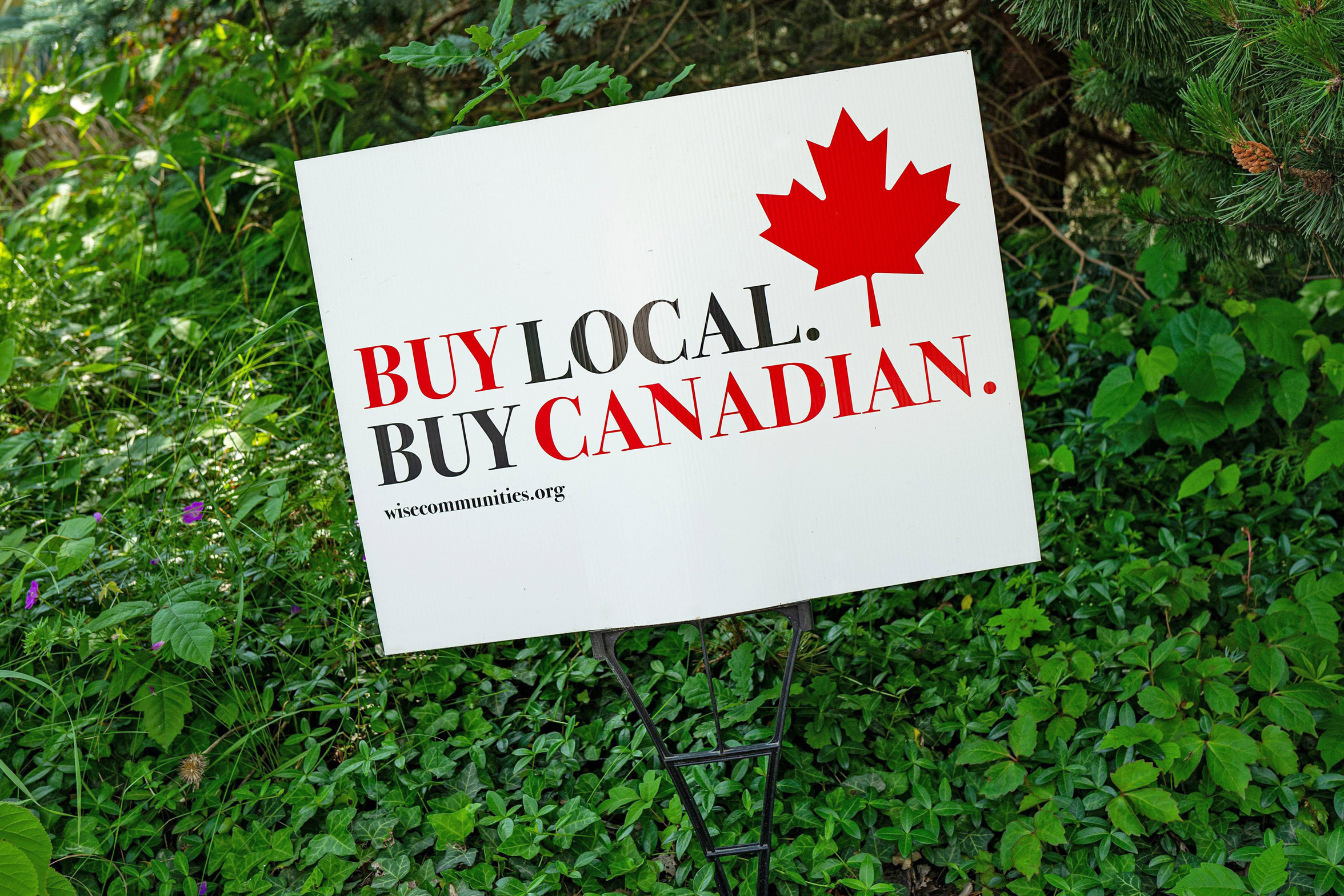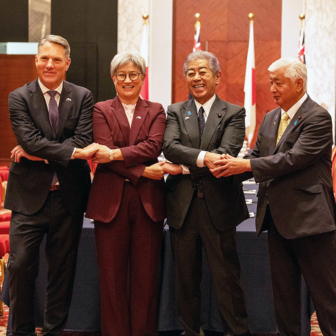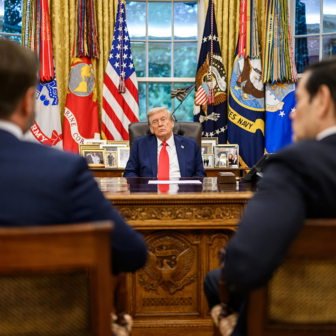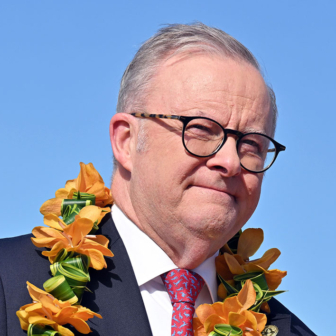One recent summer’s afternoon my wife and I were finishing a picnic with friends overlooking the North Saskatchewan River, with the prairie stretching out to the horizon in all directions. Our host brought out a watermelon, inspected it and gasped: “Wait! This is from the US, not Mexico! Do we throw it out?”
The vote was quick: we’d punish the watermelon by eating it. But Canadians have become a nation of label-readers and flag-flyers. My cousin, who had bought the contentious melon, was annoyed for not having checked its credentials.
In the past, Canadians were not big flag-flyers, but now it’s unusual to pass down a street from Vancouver to (even) Montreal without seeing a Canadian flag. Stores highlight Canadian goods with bright red maple-leaf stickers, and people in supermarkets stretch, squat and squint to check the origin of items.
This was the first time since 1967 that I’d spent the Canadian national day, the First of July, on Canadian soil. The experience was quite different from the last one long ago.
This year, we were in Campbell River, British Columbia, a town of 40,000 halfway up the east coast of Vancouver Island and a centre of sports fishing for a hundred years. The town fronts onto a two-kilometre channel, a series of islands and then the snow-capped mountains of the Coast Range on the mainland. It has recently become a base for professionals working online for companies in Vancouver, where housing is expensive and the metro population approaches three million.
Campbell River was in festive mood for the Canada Day holiday. We drove round the town counting maple-leaf flags and Canadian-themed hats and t-shirts. Long ago, such dress-up items were uncommon, and we liked to brag that Canadians were proud of not being proud of being Canadian.
There were no overt signs of antagonism — not even graffiti saying “Yankee go home” or “Trump’s grannie wears woollen knickers.” Yet one question hovered over most conversations: what would the petulant fourteen-year-old in the White House do next?
People are worried. Facetious gestures about the nationality of watermelons can’t hide the knowledge that if the US cavalry rode into Ottawa, as Putin tried to do in Ukraine, the stars and stripes would fly over the Canadian parliament in hours. Conversations sometimes turn to the nature of the civil disobedience Canadians would offer and how long it would last.
Canada has roughly the same population as Ukraine (about forty million), but Ukraine had an army of 200,000 when the Russian war began. Canada’s full-time army is less than 25,000. Ukraine also has territorial depth and land borders with friendly neighbours. The United States is Canada’s only neighbour, and nine in every ten Canadians live within a hundred miles, or 160 kilometres, of the border.
The two economies are tightly entwined, but it’s a python entwined with a garter snake — Canada’s forty million people wrapped up economically with the US’s 340 million. The US can do deep harm to the Canadian economy and perhaps drive Canadians either to beg for inclusion in the great republic or to become an exploited, Soviet-style satellite.
Of Canada’s exports, which amount to $435 billion, more than three-quarters go to the United States, much of them in the form of petroleum products and vehicles. A car manufactured in North America can cross borders a number of times before the finished vehicle rolls off an assembly line.
Annexing Canada is a possibility as old as the United States itself. Some Canadians can reel off the dates when menaces from south of the border were resisted and seen off, and then slipped into obscurity: 1775–76, 1812–14, 1867, 1891. There was even “Plan Red,” a war-gaming invasion of Canada developed by the US military in the 1920s. (A comparable Canadian plan for invading the US was put together in 1921.)
To some Americans, absorption of Canada seems inevitable — and why, they ask, would Canadians resist it? Some Canadians have thought similarly. In 1965, the year Canada adopted its maple-leaf flag, George Grant, a conservative political philosopher from an elite Ontario family, published Lament for a Nation: The Defeat of Canadian Nationalism. An independent Canada could not survive, Grant lamented, because it was too deeply bound up with the powerful capitalist experiment super-charging itself in the United States.
“Only nationalism,” Grant wrote, “could provide the incentive for planning; only planning could restrain the victory of continentalism… [N]o such combination was possible, and therefore our nation was bound to disappear.” To survive, Canada would have to create an economic and political system distinctly different from the US, a system that Canadians thought about, understood and believed in.
In the long term, Grant may prove right. But developments of the past sixty years, and especially the first six months of 2025, have led Canadians to recognise that they do live in a different socio-political environment from the United States. They see virtues in a parliamentary system that hinders the dominance of their politics by outrageously wealthy hucksters. They value their health system (however flawed), national pension plan and sensible gun laws.
Middle-class families are keen to have their kids educated in French and English. The monolingual primary school I went to in Victoria, BC, in the 1950s has been bilingual for two generations. My friends’ daughter and granddaughter were both taught by the same Québécois who moved to British Columbia in the 1980s.
As well as bilingual, Canadian governments have been committed for sixty years to making Canada multicultural — an evolving mosaic, not a bubbling melting pot.
In Alberta — Canada’s petroleum province, with its entrenched right-wing government — the newly chosen leader of the opposition New Democratic Party is Naheed Nenshi, an Ismaili Muslim whose family’s roots lie in Gujarat in western India. He retired undefeated after being elected three times as mayor of Calgary, Canada’s oil capital. In Manitoba, another prairie province, the NDP premier is Wab Kinew, an Ojibway First Nations man, only the third First Nations person to lead a US state or Canadian province.
Not all Canadians see virtues in the Canada I’m describing. The premier of oil-rich Alberta flirts with secession. Much like West Australians, Albertans often chafe at the policies of the national government, which, they say, robs the province and hampers its extractive industries. A June poll suggested 22 per cent of Albertans thought they’d be better off as an independent nation.
In Quebec, the centre of Francophone Canada, the Parti Québécois, which advocates the province’s independence, is narrowly ahead in opinion polls for the provincial election due next year. But other polling indicates that more than 60 per cent of Quebeckers would have voted against independence if a referendum on independence had been held in June.
When I left home for good on 1 July 1967, I intended that day to go to two weddings, one in White Rock, BC, the other across the border in Blaine, Washington. The venues were no more than a short taxi ride apart, but a bus accident meant I missed both. I was rescued when I got to Blaine by the mother of the groom, who had known me from kindergarten. She and her husband took me home for the night and drove me back into Canada the next day.
Like the cars manufactured in North America during the past twenty years, crossing the border in those days was a no-fuss reality. But borders ain’t what they used to be.
Donald Trump has given Canada’s sense of nationhood a hearty infusion of red and white blood cells shaped like maple leaves. When my wife and I left Canada last month, an old Japanese-Canadian friend gave us a Canadian flag, a red maple leaf rosette and two lollipops in the shape of maple leaves. Made from maple syrup of course. •




